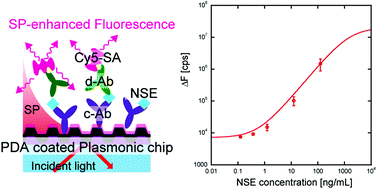Our official English website, www.x-mol.net, welcomes your feedback! (Note: you will need to create a separate account there.)
Rapid and sensitive detection of neuron specific enolase with a polydopamine coated plasmonic chip utilizing a rear-side coupling method†
Analyst ( IF 3.6 ) Pub Date : 2017-12-12 00:00:00 , DOI: 10.1039/c7an01577a M. Toma 1, 2, 3, 4, 5 , S. Izumi 3, 4, 5, 6, 7 , K. Tawa 1, 2, 3, 4, 5
Analyst ( IF 3.6 ) Pub Date : 2017-12-12 00:00:00 , DOI: 10.1039/c7an01577a M. Toma 1, 2, 3, 4, 5 , S. Izumi 3, 4, 5, 6, 7 , K. Tawa 1, 2, 3, 4, 5
Affiliation

|
A rapid and sensitive detection of a cancer marker, neuron specific enolase (NSE), is demonstrated by using a disposable silver plasmonic chip functionalized with a mussel-inspired polydopamine (PDA) coating. A plasmonic chip consisting of a diffraction grating coated with a silver thin film is used for the excitation of propagating surface plasmon resonance through a rear-side grating coupling method. Simple and quick bio-functionalization of the sensor surface is performed by PDA coating which requires 20 min for deposition, and allows direct attachment of the capture antibody without using any coupling agents. A fluorescence based sandwich immunoassay is used for the detection of NSE by utilizing surface plasmon enhanced fluorescence (SPF) spectroscopy. The developed biosensor scheme provides approximately linear sensor responses for the sample containing NSE with the concentration around the clinically important value (12 ng mL−1) in both buffer and diluted human serum (25 vol% to a buffer solution). The detection limit for NSE is 0.5 ng mL−1 (11 pM) and 1.4 ng mL−1 (30 pM) in a buffer solution and diluted human serum, respectively. The presented biosensor scheme requires a small amount of the sample down to 10 μL in human serum and a short incubation time (15 min) of the sample solution containing NSE, enabling less invasive and rapid detection of NSE. This is the first example of the sensitive sandwich immunoassay demonstrated by using a plasmonic chip for the measurement of the sample dissolved in a complex medium with a rear side coupling method, which progresses the universal use of the SPF biosensors with a disposable plasmonic chip.
中文翻译:

使用多巴胺涂层的等离激元芯片,通过背面偶联方法快速灵敏地检测神经元特异性烯醇化酶†
通过使用以贻贝启发的聚多巴胺(PDA)涂层功能化的一次性银质等离子体芯片,证明了对癌症标记物神经元特异性烯醇化酶(NSE)的快速,灵敏检测。由背面涂有银薄膜的衍射光栅构成的等离激元芯片用于通过背面光栅耦合法来激发传播的表面等离激元共振。通过PDA涂层对传感器表面进行简单而快速的生物功能化,这需要20分钟的沉积时间,并且无需使用任何偶联剂即可直接捕获抗体。基于荧光的夹心免疫测定法通过利用表面等离激元增强荧光(SPF)光谱技术检测NSE。-1)在缓冲液和稀释的人血清中(相对于缓冲液为25 vol%)。在缓冲溶液和稀释的人血清中,NSE的检出限分别为0.5 ng mL -1(11 pM)和1.4 ng mL -1(30 pM)。提出的生物传感器方案需要在人血清中的样品量低至10μL,并且含有NSE的样品溶液的孵育时间短(15分钟),从而能够以较低的侵入性和快速的速度检测NSE。这是灵敏的夹心免疫测定法的第一个实例,通过使用等离子芯片通过背面耦合方法测量溶解在复杂介质中的样品,证明了SPF生物传感器与可弃式等离子芯片的普遍应用。
更新日期:2017-12-12
中文翻译:

使用多巴胺涂层的等离激元芯片,通过背面偶联方法快速灵敏地检测神经元特异性烯醇化酶†
通过使用以贻贝启发的聚多巴胺(PDA)涂层功能化的一次性银质等离子体芯片,证明了对癌症标记物神经元特异性烯醇化酶(NSE)的快速,灵敏检测。由背面涂有银薄膜的衍射光栅构成的等离激元芯片用于通过背面光栅耦合法来激发传播的表面等离激元共振。通过PDA涂层对传感器表面进行简单而快速的生物功能化,这需要20分钟的沉积时间,并且无需使用任何偶联剂即可直接捕获抗体。基于荧光的夹心免疫测定法通过利用表面等离激元增强荧光(SPF)光谱技术检测NSE。-1)在缓冲液和稀释的人血清中(相对于缓冲液为25 vol%)。在缓冲溶液和稀释的人血清中,NSE的检出限分别为0.5 ng mL -1(11 pM)和1.4 ng mL -1(30 pM)。提出的生物传感器方案需要在人血清中的样品量低至10μL,并且含有NSE的样品溶液的孵育时间短(15分钟),从而能够以较低的侵入性和快速的速度检测NSE。这是灵敏的夹心免疫测定法的第一个实例,通过使用等离子芯片通过背面耦合方法测量溶解在复杂介质中的样品,证明了SPF生物传感器与可弃式等离子芯片的普遍应用。











































 京公网安备 11010802027423号
京公网安备 11010802027423号